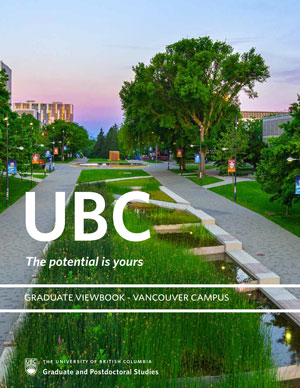Alison Elliott
Research Classification
Research Interests
Relevant Thesis-Based Degree Programs
Affiliations to Research Centres, Institutes & Clusters
Research Options
Research Methodology
Recruitment
Genetic counselling
Birth defects
Health Implementation Science
Complete these steps before you reach out to a faculty member!
- Familiarize yourself with program requirements. You want to learn as much as possible from the information available to you before you reach out to a faculty member. Be sure to visit the graduate degree program listing and program-specific websites.
- Check whether the program requires you to seek commitment from a supervisor prior to submitting an application. For some programs this is an essential step while others match successful applicants with faculty members within the first year of study. This is either indicated in the program profile under "Admission Information & Requirements" - "Prepare Application" - "Supervision" or on the program website.
- Identify specific faculty members who are conducting research in your specific area of interest.
- Establish that your research interests align with the faculty member’s research interests.
- Read up on the faculty members in the program and the research being conducted in the department.
- Familiarize yourself with their work, read their recent publications and past theses/dissertations that they supervised. Be certain that their research is indeed what you are hoping to study.
- Compose an error-free and grammatically correct email addressed to your specifically targeted faculty member, and remember to use their correct titles.
- Do not send non-specific, mass emails to everyone in the department hoping for a match.
- Address the faculty members by name. Your contact should be genuine rather than generic.
- Include a brief outline of your academic background, why you are interested in working with the faculty member, and what experience you could bring to the department. The supervision enquiry form guides you with targeted questions. Ensure to craft compelling answers to these questions.
- Highlight your achievements and why you are a top student. Faculty members receive dozens of requests from prospective students and you may have less than 30 seconds to pique someone’s interest.
- Demonstrate that you are familiar with their research:
- Convey the specific ways you are a good fit for the program.
- Convey the specific ways the program/lab/faculty member is a good fit for the research you are interested in/already conducting.
- Be enthusiastic, but don’t overdo it.
G+PS regularly provides virtual sessions that focus on admission requirements and procedures and tips how to improve your application.
ADVICE AND INSIGHTS FROM UBC FACULTY ON REACHING OUT TO SUPERVISORS
These videos contain some general advice from faculty across UBC on finding and reaching out to a potential thesis supervisor.
Supervision Enquiry
Graduate Student Supervision
Master's Student Supervision
Theses completed in 2010 or later are listed below. Please note that there is a 6-12 month delay to add the latest theses.
Introduction In British Columbia (BC), the institution responsible for funding out-of-province genetic testing (clinical genetic tests not provided by BC laboratories) changed as of June 1st 2018, from the Medical Services Plan (MSP) public health insurance to the BC Agency for Pathology and Laboratory Medicine (BCAPLM). This study aimed to investigate the effect of this changeover, by examining the trends in out-of-province testing and uptake of patient out-of-pocket (OOP) pay, from January 1st 2015 to December 31st 2019. This study also aimed to explore relationships between patient OOP pay and variables such as clinical indication, postal code, and income.Methods De-identified patient data was received from the BC Provincial Medical Genetics Program (PMGP) and the BC Cancer Hereditary Cancer Program (HCP). To examine the effect of the change in funding authority on out-of-province testing, an interrupted time series analysis was performed using PMGP data. Regression analysis using HCP data was carried out to explore the relationships between OOP pay with patient and test characteristics.Results The number of out-of-province tests completed through the PMGP, and the number of tests completed through the HCP, rose year-on-year between 2015 and 2019, with increases of 260% and 320%, respectively. Under MSP, the total number of out-of-province tests did not exhibit a statistically significant change (mean difference per month, 0.33; 95% CI -0.37, 1.02). Under BCAPLM, the number of tests increased by 2.35 per-month (95% CI 1.03, 3.66). In particular, the volume of known mutation tests, panel tests, and exome singletons increased considerably following the changeover. The likelihood of a patient having an OOP payment decreased by 87% under BCAPLM (95% CI 0.06, 0.32). For each year studied, patients who paid OOP had average annual income at least $3500 higher those who received funding, indicating that patients with lower incomes were less likely to pay OOP.Conclusions While many factors contribute to the demand for and coverage of clinical genetic testing, for example emerging data about the utility of exome sequencing for singletons vs. trios, coverage of out-of-province genetic and genomic testing has improved in BC since the introduction of BCAPLM.
View record
Publications
- Experiences with Genetic Counseling, Testing, and Diagnosis among Adolescents with a Genetic Condition: A Scoping Review (2022)
JAMA Pediatrics, 176 (2), 185-195 - Where is genetic medicine headed? Exploring the perspectives of Canadian genetic professionals on future trends using the Delphi method (2022)
European Journal of Human Genetics, - After genomic testing results: Parents’ long-term views (2021)
Journal of Genetic Counseling, - Classifications of split hand foot malformation (SHFM) should include transverse deficiencies: Why Maisels was correct (2021)
American Journal of Medical Genetics, Part A, 185 (9), 2809-2814 - Correction to: Genome-wide sequencing as a first-tier screening test for short tandem repeat expansions (Genome Medicine, (2021), 13, 1, (126), 10.1186/s13073-021-00932-9) (2021)
Genome Medicine, 13 (1) - Correction to: Toward the diagnosis of rare childhood genetic diseases: what do parents value most? (European Journal of Human Genetics, (2021), 29, 10, (1491-1501), 10.1038/s41431-021-00882-1) (2021)
European Journal of Human Genetics, 29 (10), 1589 - Far and wide: Exploring provider utilization of remote service provision for genome-wide sequencing in Canada (2021)
Molecular Genetics and Genomic Medicine, - GeneBreaker: Variant simulation to improve the diagnosis of Mendelian rare genetic diseases (2021)
Human Mutation, 42 (4), 346-358 - Genetic counseling considerations in cerebral palsy (2021)
Molecular Genetics and Metabolism, - Genetic counseling research and COVID-19: A lesson in resiliency (2021)
Journal of Genetic Counseling, - Genetic counselors and legal recognition: A made-for-Canada approach (2021)
Journal of Genetic Counseling, - Genome-wide sequencing as a first-tier screening test for short tandem repeat expansions (2021)
Genome Medicine, 13 (1) - Integration of genetic counsellors in genomic testing triage: Outcomes of a Genomic Consultation Service in British Columbia, Canada (2021)
European Journal of Medical Genetics, 64 (7) - NAA10 p.(N101K) disrupts N-terminal acetyltransferase complex NatA and is associated with developmental delay and hemihypertrophy (2021)
European Journal of Human Genetics, 29 (2), 280-288 - New cases that expand the genotypic and phenotypic spectrum of Congenital NAD Deficiency Disorder (2021)
Human Mutation, 42 (7), 862-876 - Out-of-pocket and private pay in clinical genetic testing: A scoping review (2021)
Clinical Genetics, 100 (5), 504-521 - Rapid genome-wide sequencing in a neonatal intensive care unit: A retrospective qualitative exploration of parental experiences (2021)
Journal of Genetic Counseling, 30 (2), 616-629 - Somatic mosaicism detected by genome-wide sequencing in 500 parent–child trios with suspected genetic disease: clinical and genetic counseling implications (2021)
Cold Spring Harbor Molecular Case Studies, 7 (6) - Targeted treatment of immune thrombocytopenia in CTLA-4 insufficiency: a case report (2021)
British Journal of Haematology, - Toward the diagnosis of rare childhood genetic diseases: what do parents value most? (2021)
European Journal of Human Genetics, 29 (10), 1491-1501 - Utilization and uptake of clinical genetics services in high-income countries: A scoping review (2021)
Health Policy, 125 (7), 877-887 - Utilization of telehealth in paediatric genome-wide sequencing: Health services implementation issues in the CAUSES Study (2021)
Journal of Telemedicine and Telecare, - Correction: The composition and capacity of the clinical genetics workforce in high-income countries: a scoping review. (2020)
Genetics in medicine : official journal of the American College of Medical Genetics, - De novo TBR1 variants cause a neurocognitive phenotype with ID and autistic traits: report of 25 new individuals and review of the literature. (2020)
European journal of human genetics : EJHG, - Genetic counseling and genome sequencing in pediatric rare disease (2020)
Cold Spring Harbor Perspectives in Medicine, 10 (3) - Shortened consent forms for genome-wide sequencing: Parent and provider perspectives (2020)
Molecular Genetics and Genomic Medicine, 8 (7) - The composition and capacity of the clinical genetics workforce in high-income countries: a scoping review. (2020)
Genetics in medicine : official journal of the American College of Medical Genetics, - Canadian genetic healthcare professionals’ attitudes towards discussing private pay options with patients (2019)
Molecular Genetics and Genomic Medicine, 7 (4) - Genetic counseling considerations with rapid genome-wide sequencing in a neonatal intensive care unit (2019)
Journal of Genetic Counseling, 28 (2), 263-272 - New developmental syndromes: Understanding the family experience (2019)
Journal of Genetic Counseling, 28 (2), 202-212 - RAPIDOMICS: rapid genome-wide sequencing in a neonatal intensive care unit-successes and challenges. (2019)
European journal of pediatrics, - Renpenning syndrome in a female. (2019)
American journal of medical genetics. Part A, - Support, information, and integration of genetics for children with congenital lower limb deficiencies in British Columbia, Canada (2019)
Paediatrics and Child Health (Canada), 24 (6), 395-401 - The cost trajectory of the diagnostic care pathway for children with suspected genetic disorders. (2019)
Genetics in medicine : official journal of the American College of Medical Genetics, - The Impact of Intensive Versus Standard Anthelminthic Treatment on Allergy-related Outcomes, Helminth Infection Intensity, and Helminth-related Morbidity in Lake Victoria Fishing Communities, Uganda: Results from the LaVIISWA Cluster-randomized Trial (2019)
Clinical Infectious Diseases, 68 (10), 1665-1674 - Atypical cerebral palsy: genomics analysis enables precision medicine. (2018)
Genetics in medicine : official journal of the American College of Medical Genetics, - Evaluating the use of parental reports to estimate health care resource utilization in children with suspected genetic disorders (2018)
Journal of Evaluation in Clinical Practice, 24 (2), 416-422 - Schistosoma mansoni-specific immune responses and allergy in Uganda (2018)
Parasite Immunology, 40 (1) - The cost and diagnostic yield of exome sequencing for children with suspected genetic disorders: a benchmarking study (2018)
Genetics in Medicine, 20 (9), 1013-1021 - The Genomic Consultation Service: A clinical service designed to improve patient selection for genome-wide sequencing in British Columbia (2018)
Molecular Genetics and Genomic Medicine, 6 (4), 592-600 - The importance of genetic counselling in genome-wide sequencing (2018)
Nature Reviews Genetics, 19 (12), 735-736 - Heart-hand syndrome IV: a second family with LMNA-related cardiomyopathy and brachydactyly (2017)
Clinical Genetics, 91 (3), 499-500 - Loss-of-Function and Gain-of-Function Mutations in KCNQ5 Cause Intellectual Disability or Epileptic Encephalopathy. (2017)
American journal of human genetics, - Case Report: Direct Access Genetic Testing and A False-Positive Result For Long QT Syndrome (2016)
Journal of Genetic Counseling, 25 (1), 25-31 - CCC- and WASH-mediated endosomal sorting of LDLR is required for normal clearance of circulating LDL (2016)
Nature Communications, 7 - Clinical and radiographic delineation of Bent Bone Dysplasia-FGFR2 type or Bent Bone Dysplasia with Distinctive Clavicles and Angel-shaped Phalanges (2016)
American Journal of Medical Genetics, Part A, 170 (10), 2652-2661 - Recommendations for the integration of genomics into clinical practice (2016)
Genetics in Medicine, - Derogatory nomenclature is still being used: The example of split hand/foot (2015)
American Journal of Medical Genetics, Part A, 167 (4), 928-929 - Schistosoma mansoni and HIV infection in a Ugandan population with high HIV and helminth prevalence (2015)
Tropical Medicine and International Health, 20 (9), 1201-1208 - Vascular patterning regulates interdigital cell death by a ros-mediated mechanism (2015)
Development (Cambridge), 142 (4), 672-680 - Evaluation of a Clinical Genetics Service – A Quality Initiative (2014)
Journal of Genetic Counseling, 23 (5), 881-889 - A novel mutation in KIAA0196: Identification of a gene involved in Ritscher-Schinzel/3C syndrome in a First Nations cohort (2013)
Journal of Medical Genetics, 50 (12), 819-822 - Radiographic characterization of the hands in Ritscher-Schinzel/3-C syndrome (2013)
SpringerPlus, 2 (1), 1-6 - Microdeletion 9q22.3 syndrome includes metopic craniosynostosis, hydrocephalus, macrosomia, and developmental delay (2012)
American Journal of Medical Genetics, Part A, 158 A (2), 391-399 - Trends in telehealth versus on-site clinical genetics appointments in Manitoba: A comparative study (2012)
Journal of Genetic Counseling, 21 (2), 337-344 - Potential teratogenic effects of allopurinol: A case report (2011)
American Journal of Medical Genetics, Part A, 155 (9), 2247-2252 - A novel COMP mutation in an Inuit patient with pseudoachondroplasia and severe short stature. (2010)
Genetics and molecular research : GMR, 9 (3), 1785-1790 - The developmental spectrum of proximal radioulnar synostosis (2010)
Skeletal Radiology, 39 (1), 49-54 - Central ray deficiency with extensive syndactyly: A dilemma for classification (2009)
Genetic Counseling, 20 (1), 27-43 - The carpal bones in Poland syndrome (2009)
Skeletal Radiology, 38 (6), 585-591 - The association of split hand foot malformation (SHFM) and congenital heart defects (2008)
Birth Defects Research Part A - Clinical and Molecular Teratology, 82 (6), 425-434 - Triphalangeal thumb in association with split hand/foot: A phenotypic marker for SHFM3? (2007)
Birth Defects Research Part A - Clinical and Molecular Teratology, 79 (1), 58-61 - Clinical and epidemiological findings in patients with central ray deficiency: Split hand foot malformation (SHFM) in Manitoba, Canada (2006)
American Journal of Medical Genetics, Part A, 140 (13), 1428-1439 - Genotype-phenotype correlations in mapped split hand foot malformation (SHFM) patients (2006)
American Journal of Medical Genetics, Part A, 140 (13), 1419-1427 - Letter re: Fibula aplasia, tibial campomelia, and oligodactyly [5] (2006)
American Journal of Medical Genetics, 140 A (10), 1127 - Osteocraniostenosis-hypomineralized skull with gracile long bones and splenic hypoplasia. Four new cases with distinctive chondro-osseous morphology (2006)
American Journal of Medical Genetics, Part A, 140 (14), 1553-1563 - Discrepancies in upper and lower limb patterning in split hand foot malformation (2005)
Clinical Genetics, 68 (5), 408-423 - Hand involvement in schmid metaphyseal chondrodysplasia (2005)
American Journal of Medical Genetics, 132 A (2), 191-193 - Split hand foot malformation (SHFM) (2005)
Clinical Genetics, 68 (6), 501-505 - Cenani-Lenz syndactyly in a patient with features of Kabuki syndrome (2004)
Clinical Dysmorphology, 13 (3), 143-150 - The duplicated longitudinal epiphysis or "kissing delta phalanx": Evolution and variation in three different disorders (2004)
Skeletal Radiology, 33 (6), 345-351 - A distinctive type of metaphyseal chondrodysplasia with characteristic thickening of the distal ulna and radius: Possible metaphyseal chondrodysplasia-Rosenberg (2003)
American Journal of Medical Genetics, 119 A (1), 50-56 - Cerebro-osseous-digital syndrome: Four new cases of a lethal skeletal dysplasia - Distinct from Neu-Laxova syndrome (2002)
American Journal of Medical Genetics, 109 (2), 139-148 - Spectrum of dolichospondylic dysplasia: Two new patients with distinctive findings (2002)
American Journal of Medical Genetics, 113 (4), 351-361 - Member of the ampakine class of memory enhancers prolongs the single channel open time of reconstituted AMPA receptors (2001)
Synapse, 40 (2), 154-158 - Progressive erosive arthropathy with contractures, multicentric osteolysis-like changes, characteristic craniofacial appearance, and dermatological abnormalities: A new syndrome? (2001)
American Journal of Medical Genetics, 100 (3), 198-203 - New autosomal dominant syndrome reminiscent of Coffin-Siris syndrome and Brachymorphism-Onychodysplasia-Dysphalangism syndrome (2000)
Clinical Dysmorphology, 9 (1), 15-19 - 3.0.co;2-e" target="_blank">Scapuloiliac dysostosis (Kosenow syndrome, Pelvis-Shoulder Dysplasia) spectrum: Three additional cases (2000)
American Journal of Medical Genetics, 95 (5), 496-506 - 3.0.co;2-3" target="_blank">Dyskeratosis congenita: An autosomal recessive variant (1999)
American Journal of Medical Genetics, 83 (3), 178-182 - 3.0.co;2-l" target="_blank">Deletion of 22q11 in two brothers with different phenotype (1998)
American Journal of Medical Genetics, 75 (3), 288-291 - Fine localization of the Nijmegen breakage syndrome gene to 8q21: Evidence for a common founder haplotype (1998)
American Journal of Human Genetics, 63 (1), 125-134 - 3.0.co;2-l" target="_blank">Further examples of autosomal dominant transmission of nonsyndromic aplasia cutis congenita. (1997)
American journal of medical genetics, 73 (4), 495-496 - Another case of the human homologue of the mouse mutant disorganization. (1996)
American journal of medical genetics, 61 (1), 94 - 3.0.co;2-x" target="_blank">New syndrome?: MCA/MR syndrome with multiple circumferential skin creases (1996)
American Journal of Medical Genetics, 62 (1), 23-25 - 3.0.co;2-0" target="_blank">Possible new variant of Nijmegen breakage syndrome (1996)
American Journal of Medical Genetics, 65 (1), 21-26 - Schinzel-Giedion syndrome: Further delineation of the phenotype (1996)
Clinical Dysmorphology, 5 (2), 135-142 - 3.0.co;2-g" target="_blank">Skeletal and cardiac malformations with thrombocytopenia: A new syndrome? (1996)
American Journal of Medical Genetics, 64 (3), 497-500 - Developmental anomalies suggestive of the human homologue of the mouse mutant disorganization (1995)
American Journal of Medical Genetics, 55 (2), 240-243 - Severe intrauterine growth retardation with increased mitomycin C sensitivity, or Nijmegen breakage syndrome? (1995)
Journal of Medical Genetics, 32 (12), 998
Membership Status
Member of G+PS
View explanation of statuses
Location
Program Affiliations
Academic Unit(s)
If this is your researcher profile you can log in to the Faculty & Staff portal to update your details and provide recruitment preferences.



